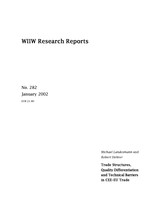Trade Structures, Quality Differentiation and Technical Barriers in CEE-EU Trade
Michael Landesmann and Robert Stehrer
wiiw Research Report No. 282, January 2002
29 pages including 19 Tables
In this paper we attempt to quantify the incidence of different types of technical barriers to trade (TBTs) on trade structures between seven Central and Eastern European countries (Hungary, Poland, Czech Republic, Slovakia, Slovenia, Bulgaria, and Romania) and the European Union at the industrial level. The issue becomes important as CEECs as candidates for EU membership will become subject to the same Single Market arrangements that regulate access of EU members to each other's markets. As compared to the current situation, compliance with EU regulations can be seen as enabling easier access of CEE producers to EU markets in the long run even though they might impose costs of adjustment in the short and medium run. This is the topic analysed in a quantitative manner. We start in this paper by reporting the most important facts on CEE-EU trade structures and their developments. We analyse the export structure of CEECs, the development of market shares and the CEECs' position with respect to export unit values. Second, we try to quantify the coverage of technical barriers to trade in the CEECs' trade structures with the European Union. All this is done at an industrial level based on product level information on TBTs. Finally, we make a tentative attempt to see whether a relationship may be established between the incidence of different types of trade barriers and the market performance of CEE exporters. We look here both at the impact on market share growth and on 'quality upgrading' as proxied by relative export price movements.
Keywords: international trade, trade barriers, CEE-EU trade, product differentiation in international trade
JEL classification: F02, F13, F14, F15, L15
Countries covered: Bulgaria, Czechia, European Union, Hungary, Poland, Romania, Slovakia, Slovenia, SEE, Visegrad countries
Research Areas: International Trade, Competitiveness and FDI
